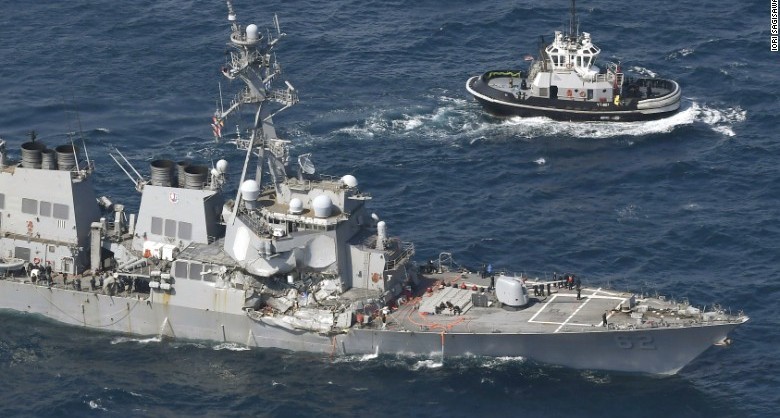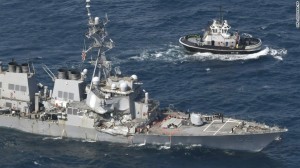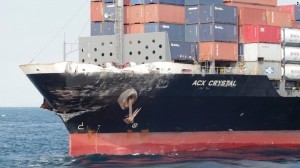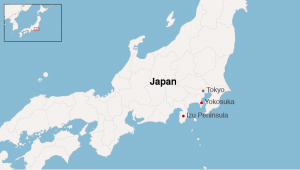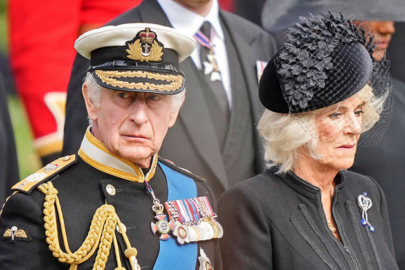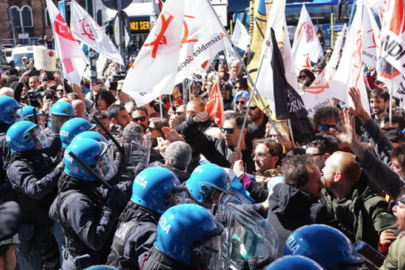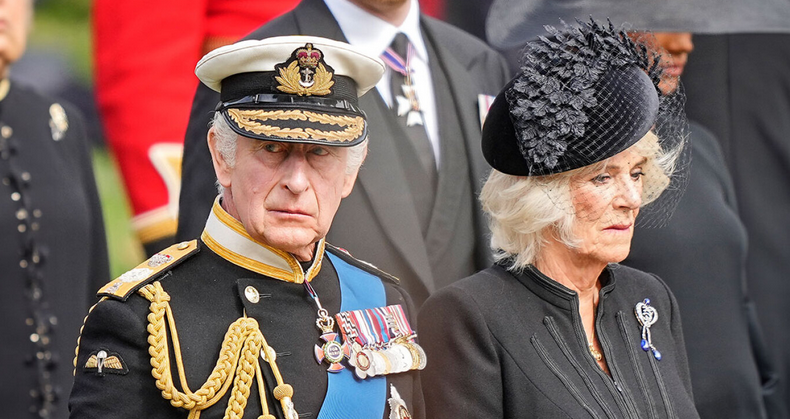Seven US sailors are missing and the commanding officer of a US destroyer is among the injured after the warship collided with a merchant ship off the coast of Japan, the US Navy said Friday.
The guided-missile destroyer USS Fitzgerald suffered damage to its starboard side above and below the waterline in the incident.
Cmdr. Bryce Benson, commander of the Fitzgerald, was one of three injured sailors who needed to be flown to a naval hospital in Yokosuka, Japan.
The two ships collided about 2:30 a.m. local time in the Pacific Ocean about 56 nautical miles from the port of Yokosuka and 12 miles off the Izu Peninsula, the Japanese coast guard said.
(The USS Fitzgerald heads to Yokosuka, home base of the 7th Fleet, beside a US tugboat, off Shimoda, Japan on Saturday)
The Fitzgerald had left the US naval base in Yokosuka, where it is based, earlier Friday for routine operations in the area, a US Naval Forces Japan spokesman said. The damage to the Fitzgerald resulted in some flooding.
The warship is now being towed back to Yokosuka, escorted by a Japanese coast guard ship, officials said.
The vessel was taking on water after the incident, but the crew was working to stabilize the ship by pumping water out, a US Navy official said.
The ship’s commander was evacuated by a Japanese coast guard helicopter while US military copters evacuated two injured US sailors. All three are in stable condition at the US Naval Hospital in Yokosuka, said Cmdr. Ron Flanders, public affairs officer for US Naval Forces Japan.
The Japanese coast guard said four of its vessels and one helicopter were assisting the US Navy destroyer with damage assessment and searching the area around the ship, working on the possibility that some of the missing may have fallen into the ocean.
Another US warship, the guided-missile destroyer USS Dewey, was involved in the recovery operations, US officials said.
Officials said the merchant vessel involved in the collision is the ACX Crystal, a container ship flagged in the Philippines.
The ship tracking website marinetraffic.com shows the ship had left the Japanese port of Nagoya on Friday evening. It was expected to dock at a Tokyo Bay port around 4:30 p.m. local time, officials said after the accident, adding the container ship was operating under charter to a Japanese shipping company.
Photos of the Crystal showed damage to its bow.
(In this photo released by Japan’s coast guard, the damage to Philippine container ship ACX Crystal is seen after it had collided with the USS Fitzgerald in the waters off Izu Peninsula)
The Japanese coast guard said the area of the collision, 12 miles (20 kilometers) off the tip of the Izu Peninsula, is known for its heavy maritime traffic and has been the site of numerous past accidents.
Carl Schuster, former director of operations at the US Pacific Command’s Joint Intelligence Center and a Hawaii Pacific University professor, said in a busy shipping lane the ships could have been in a “restricted navigation” situation, meaning they would have to observe strict rules for movement and positioning in relation to other vessels in their vicinity.
Those rules leave vessels tight room to maneuver as turning away from one ship could put your vessel at risk of an even more serious incident with another, Schuster said.
The Fitzgerald is an Arleigh Burke-class guided-missile destroyer with a crew of approximately 330 sailors.
The ship, displacing 10,000 tons and 505 feet long, completed $21 million in upgrades and repairs in February and is forward-deployed to Yokosuka, supporting security and stability in the Indo-Asia-Pacific region, the service said.
Marinetraffic.com says the Crystal displaces 29,060 tons and is 741 feet long.
Schuster said the larger size of the container ship compared to the US destroyer left the smaller ship vulnerable in the collision.
(An injured USS Fitzgerald crew member is carried by U.S. military personnel, left, and Japanese Maritime Self-Defense Force members upon arriving to the U.S. Naval Base in Yokosuka Japan on Saturday)
The force of the impact could have thrown sailors overboard who were standing on the opposite side of the destroyer from where it was struck, he said.
That could account for the missing sailors, who may have been on deck on watch or even just relaxing in the night air, he said.
(Cmdr. Bryce Benson)
Sailors could also been trapped in compartments below deck, Schuster said, pointing out that container ships have a bulbous bow below the water line, which could have plowed into the US warship.
According to a Navy news release from last month, Benson, the Fitzgerald’s commander, was new to the position, taking command of the vessel May 13 after serving as the ship’s executive officer, or second in command, since November 2015.
The Fitzgerald is the second command for Benson, a 1999 Naval ROTC graduate of Marquette University. He commanded the minesweeper USS Guardian, operating out of Sasebo, Japan, from 2008 to 2010, before taking shore assignments in Washington and with US Pacific Command.
Correction: An earlier version of this article incorrectly described the status of the commanding officer. He was medevaced for treatment.

